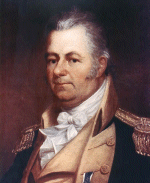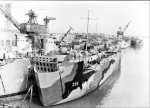 |
38k |
Namesake
Thomas Truxtun was born on 17 February 1755 near Hempstead, Long Island, New York. When his father died in 1765, young Truxtun came under the guardianship of John Troup
of Jamaica, Long Island. Two years later, at the age of 12, he embarked upon a seafaring career, sailing with Captains Joseph Holmes and James Chambers in the London
trade. At 16, he was pressed into service in the Royal Navy on board HMS Prudent. Truxtun's British commanding officer observed the lad's natural abilities and offered
him aid in securing a midshipman's warrant. However, Truxtun declined, obtained his release through the good offices of influential friends, and returned to mercantile
service. By the age of 20, he had risen to command of Andrew Caldwell in which he brought large quantities of gunpowder into Philadelphia in 1775. Later that year, his
ship was seized by HMS Argo off St. Kitts in the West Indies, an act that caused some natural resentment in the young sea captain. By the time Truxtun made his way back
to Philadelphia, the colonies had reached the point of open rupture with the mother country. He signed on as a lieutenant in Congress, the first privateer to be fitted
out for service against Great Britain. During the remainder of 1776, Truxtun participated in the capture of several prizes off the coast of Cuba. In 1777, he fitted out
Continental Navy sloop Independence and sailed her to the Azores where he took three prizes. Upon his return, Truxtun fitted out Mars and made a highly successful
cruise in the English Channel. Successively, he commanded Independence once more and then, in turn, Commerce and St. James. In addition to privateering, Truxtun's ships
also carried cargoes of military stores to the colonies. On one voyage in St. James, he landed a valuable cargo of gunpowder and military stores at Philadelphia. At a
dinner to celebrate the feat, George Washington declared that Truxtun's services had been worth those of a regiment. On another occasion, St. Jamesóstill under his commandócarried Thomas Barclay, the American consul, to France. Following the Revolution, Truxtun resumed his career in mercantile service and commanded Canton, the first Philadelphia ship to enter the China trade. When the United States Navy was organized, he was selected as one of its first six captains on 4 June 1798. He was assigned command of one of the new frigates then under construction. His ship, Constellation, was completed late in June; and he put to sea immediately to prosecute the undeclared naval war with revolutionary France. The frigate, accompanied by a squadron of smaller ships, operated in the West Indies between St. Christopher and Puerto Rico. On 9 February 1799, Truxtun scored the first of his two most famous victories. After an hour's fight, Constellation battered Insurgente into submission, killing 29 and wounding 44 of the French frigate's crew. Truxtun brought Insurgente into St. Christopher where she was refitted and commissioned in the United States Navy. Almost a year later, on 1 February 1800, he sighted the 50-gun French frigate La Vengeance, chased her all day, and finally overhauled her that evening. For the next five hours, Truxtun used superior American gunnery and the prevailing heavy seas to his advantage and, by 0100, completely overcame La Vengeance's initial broadside superiority. During the action, the French warship had struck her colors several times, but darkness had prevented Truxtun from seeing the signal. Accordingly, the engagement continued until every gun on board the Frenchman went silent. The French frigate then sheered off to flee, and Constellation's battle-damaged rigging made it impossible for the American frigate to pursue her escaping victim. After refitting Constellation at Jamaica, Truxtun returned with her to Norfolk late in March. After commanding frigate President in the West Indies from mid-1800 to May 1801, Truxtun was appointed to command the squadron then fitting out for the Tripolitan expedition. Through a misunderstanding engendered by his request to have a captain appointed to command his flagship Chesapeake, Truxtun's unintended resignation from the Navy was accepted in Washington. Commodore Truxtun retired first to Perth Amboy, N.J., and thence to Philadelphia, where he was active in local politics for the rest of his life. In 1809, he led the agitation in Philadelphia against the Embargo. The following year, he was unsuccessful in his bid for a seat in Congress under the Federalist banner. From 1816 to 1819, Truxtun served as the sheriff of Philadelphia. Commodore Truxtun died at Philadelphia on 5 May 1822 and was interred there at Christ Church. |
Bill Gonyo |
 |
88k |
USS LSM-396, and
USS LSM-308 at the fitting out piers at US Navy Yard, Charleston, S.C. Other ships in this photo include:
USS LSM-309,
USS LSM 389,
USS LSM-390,
USS LSM-391,
USS LSM-392,
USS LSM-393,
USS LSM-394,
USS LSM-395,
USS LSM-397,
USS LSM-398,
USS Ray K. Edwards (APD-96),
USS Arthur L. Bristol (APD-97),
USS Truxtun (APD-98), and
USS Upham (APD-99).
US Navy Yard Charleston photo # 132-46, dated 10 January 1945. |
USS LSM / LSMR Association |





